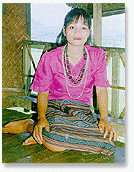Home » Ethnic People » Ha Nhi
The Ha Nhi People

Also called U Ni and Xa U Ni, there are about 12,500 Ha Nhi, in the provinces of Lai Chau and Lao Cai. Ha Nhi language belongs to the Tibeto-Burman Group, while their culture is based on ancestor worship.
Building road leading to the villages of the Ha Nhi in Muong Te (Lai Chau province).
They live on rice cultivation of burnt-over land or terraced fields. They are one of the groups that are highly skilled at building terraced fields on mountain slopes, digging canals and building small dams. They use ploughs and harrows pulled by oxen and buffaloes to work the fields. The gardens are often close to their houses.
Animal husbandry is developed as well as cloth weaving, and basketry. Most of the Ha Nhi make their own clothes. Women’s dress varies depending on the region. The women in Lai Chau have colourful and decorated dresses, while Lao Cai women wear only dark indigo.
Each Ha Nhi hamlet contains 60 households. The Ha Nhi consists of many family lineages. Each lineage comprises many branches. Every year, at Tet (New Year’s Day), the people of the same lineage get together to listen to an elderly man speaking about their ancestors. Some lineages can recall their ancestors up to 40 generations in the past. The children often take the name of their father or of an animal as their middle names. The young men and women are free to choose their partners. Each marriage goes through two stages. In the first stage, the young man and women become husband and wife. The bride comes to live with her husband’s family and takes the family name of the husband according to the custom of the Ha Nhi in Lai Chau province. The second stage is organized when the couple gets rich or has a child.
Funeral customs vary according to regions, but some common practices are observed. When a person dies, the partition marking off the bedroom of the deceased is dismantled, as well as the altar to the ancestors. The dead body is placed on a bed in the kitchen, and auspicious hours and days must be chosen for burial. To determine the place of burial, an egg is tossed in the air and the grave dug where the egg hits the ground and breaks. There are no cemeteries. Around the grave, stones are piled up to make a funeral house or a protective fence.
The Ha Nhi possess many ancient tales and stories in long verses. The young men and women play their own dances according to rhythms and accompanied by musical instruments. The young couples used to expose their love by playing leaf panpipe, lip organ and vertical flute. The young girls like to play am ba, met du, tuy huy or nat xi (various kinds of traditional flutes) when night falls. The young boys like to play la khu, a string zither. Besides, at the festivals, drums, cymbals and castanets are performed. The Ha Nhi also have many songs such as lullabies, duet songs, wedding songs, mourning songs and songs reserved for new houses, receiving guests and welcoming Tet holidays. Particularly, a wedding song of the Ha Nhi in Muong Te District of Lai Chau province is composed of 400 verses.

